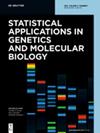注释细菌DNA的马尔可夫性和条件独立性。
IF 0.4
4区 数学
Q4 BIOCHEMISTRY & MOLECULAR BIOLOGY
Statistical Applications in Genetics and Molecular Biology
Pub Date : 2014-12-01
DOI:10.1515/sagmb-2014-0002
引用次数: 5
摘要
我们在许多细菌基因组中探索了DNA的概率结构,并得出结论,在编码区和非编码区之间的边界存在一种形式的马尔可夫性,即细菌基因组注释的START和STOP密码子序列。该序列满足条件独立性质,允许其控制马尔可夫链从START和STOP密码子的丰度唯一识别。进一步,我们证明了标注的start和stop序列符合Chargaff第二奇偶规则。本文章由计算机程序翻译,如有差异,请以英文原文为准。
Markovianness and conditional independence in annotated bacterial DNA.
We explore the probabilistic structure of DNA in a number of bacterial genomes and conclude that a form of Markovianness is present at the boundaries between coding and non-coding regions, that is, the sequence of START and STOP codons annotated for the bacterial genome. This sequence is shown to satisfy a conditional independence property which allows its governing Markov chain to be uniquely identified from the abundances of START and STOP codons. Furthermore, we show that the annotated sequence of STARTs and STOPs complies with Chargaff's second parity rule.
求助全文
通过发布文献求助,成功后即可免费获取论文全文。
去求助
来源期刊

Statistical Applications in Genetics and Molecular Biology
BIOCHEMISTRY & MOLECULAR BIOLOGY-MATHEMATICAL & COMPUTATIONAL BIOLOGY
自引率
11.10%
发文量
8
期刊介绍:
Statistical Applications in Genetics and Molecular Biology seeks to publish significant research on the application of statistical ideas to problems arising from computational biology. The focus of the papers should be on the relevant statistical issues but should contain a succinct description of the relevant biological problem being considered. The range of topics is wide and will include topics such as linkage mapping, association studies, gene finding and sequence alignment, protein structure prediction, design and analysis of microarray data, molecular evolution and phylogenetic trees, DNA topology, and data base search strategies. Both original research and review articles will be warmly received.
 求助内容:
求助内容: 应助结果提醒方式:
应助结果提醒方式:


